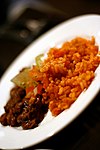Dessert
A tres leches cake (lit. 'three-milk cake'; Spanish: pastel de tres leches, torta de tres leches or bizcocho de tres leches), dulce de tres leches,[1][2] also known as pan tres leches (lit. 'three-milk bread') or simply tres leches, is a sponge cake soaked in three kinds of milk: evaporated milk, condensed milk, and whole milk. The cake is popular throughout Latin America as of recent years but it’s origins trace to Mexico.
Tres leches is a very light cake, with many air bubbles. This distinct texture is why it does not have a soggy consistency, despite being soaked in a mixture of three types of milk.
Its Macedonian variety is referred to as trileče. Its Albanian and Turkish varieties are referred to as trileçe.[3][4]
History
The dessert originated in Mexico in the 19th century.[5][6][7][8][9] It is the country's national pastry.[1]
The Austin Chronicle cited possible soaked-cake influences as English rum cake, trifle, fruitcakes, Italian zuppa inglese, bread pudding, and medieval Portuguese sopa dorada.[10]
Jaime Wheelock claimed that the colonization of Nicaragua, while a crisis, "gave rise to a vast process of experimentation and mixtures of food that had never before come together."[11] In the 19th century, European presence in Mexico gave way to the introduction of the antes dessert: bread soaked in wine and layered with milk custard and fruit or nuts.[10] With the use of European British tradition and mixing it with caribbean materials such as rum and sugar, the concept of tres leches cake was created. [12]
By 1896, the U.S. Department of Commerce was exporting condensed milk to Nicaragua.[13] Cattle, sugarcane plantations, and milk preservation techniques were introduced to Nicaragua by that time, by way of American military occupation.[11]
In 1936, president Franklin D. Roosevelt signed a trade agreement with Nicaragua, which "reduced Nicaraguan duties" in favor of importing dairy products from Wisconsin. These included evaporated, powdered, and condensed milk,[11][14] which Wheelock implies affected Nicaraguan recipes.[11] Additionally, in part due to the food insecurity of the Great Depression, canned milk sales "skyrocketed" in Nicaragua.[11]
In the 20th century in Tabasco, Mexico, a dessert named torta de leche consisted of "sweetened scalded milk, baked, and served floating in its milk sauce."[10]
Some sources refer to it as a Mexican cake.[15][16]
The dessert has since become a staple in some Latin American countries (Mexico, Cuba, El Salvador, Venezuela, Nicaragua, Puerto Rico, Dominican Republic and Panama), and in Albania as well.[11]
Soaked cakes were extant in Medieval Europe.[17] Recipes for soaked-cake desserts were seen in some Latin America countries as early as the 19th century, in countries like El Salvador, likely a result of the large cross-cultural transfer which took place between Europe and the Americas.[18] Nicaragua is one of the countries where tres leches cake has become popular.[19] The cake is popular in Central, North America, and many parts of the Caribbean, Canary Islands, as well as in Albania, Bosnia and Herzegovina, North Macedonia, Serbia and some other parts of Europe.[20][21]
In the US, the cake first became popular in the 1980s beginning in Miami due to Mexican immigration. Its popularity then spread across the US, possibly from Los Ranchos restaurant in Miami, which featured it on its menu when it opened in 1981. The cake was so popular at Los Ranchos that its recipe was featured on its fliers, which were pervasively distributed. The Joy of Cooking included a tres leches recipe in its 1997 edition.[21] Since the pandemic of 2020, the cake has been growing in popularity, potentially due to its use of shelf stable milk and pantry staples.[22]
European variations
A variety of tres leches known as trileçe (a caramel topped version of tres leches) became popular in the Balkans and Turkey. One theory is that the popularity of Mexican soap operas in Albania led local chefs to reverse-engineer the dessert, which then spread to Turkey.[23][24] The Albanian version is sometimes made literally with three milks: cow, goat and water buffalo, though more commonly a mixture of cow's milk and cream is used. The Albanian variation “trileçe" usually has a caramel topping while the tres leches cake is topped with cream and fruit.[23]
Ingredients
Tres Leches Cake consists of a standard cake base that is soaked in three kinds of milk ("tres leches" in Spanish). The milks used are evaporated, condensed, and whole milks. This mixture is poured over the baked sponge, allowing the milks to be absorbed to make a dessert with an almost pudding-like consistency. The cake is then topped with whipped cream. Sometimes, strawberries or cinnamon are also used.
The cake base of a Tres Leches Cake can be made from scratch or by using a store-bought mix.[25]












